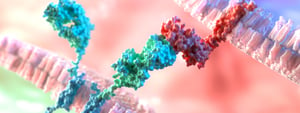Using a cutting-edge immunotherapy, called CAR (Chimeric Antigen Receptor), researchers from the Baylor College of Medicine in Houston have managed to block neuroblastoma, a cancer of the nervous system, in several children who have been unresponsive to all other treatments. This is still an experimental result, but also the first time that it has happened, and it is highly significant.
How does the CAR technique work? Oncologists extract certain kinds of immune system cells (lymphocytes) from the patient, then duplicate them in the lab and reinforce them using genetic engineering. Which consists in inserting a receptor (the Chimeric Antigen Receptor) that is particularly good at latching onto the cancer cells with the ultimate purpose of destroying them.
The lymphocytes reinforced in this way are then reinserted into the blood of the patient, so that they can do their work and beat the disease.
Up until now (this is a recent technique) T-lymphocytes had always been used by transforming them into CAR-T cells using genetic engineering.
However, these “weapons” have been proven to be effective in treating certain types of blood cancers (leukaemia and lymphoma), but not solid tumours, like cancers of the nervous system, or other organs, for various reasons. In particular, due to their inability to reach and survive in the micro-environment that surrounds these types of tumours.
The researchers from the Baylor College of Medicine decided, therefore, to go one step further and used another type of lymphocytes, i.e. those known as Natural Killer T (NKT), to try to contain the neuroblastoma.
As they wrote in the scientific journal Nature Medicine, they chose this “category” of lymphocytes because they appear to be particularly effective in treating tumours.
NKTs are, however, less numerous than T-lymphocytes, more heterogeneous and much more difficult to extract and modify, in order to transform them into CAR cells.
Using sophisticated techniques, the researchers from the Baylor College of Medicine managed to do all of this and they also discovered how to make CAR-NKT cells produce a substance, interleukin-15, capable of boosting the immune reaction against the tumour, further enhancing its effectiveness.
After many tests in vitro and on laboratory animals, the US oncologists treated around twenty children with a neuroblastoma that had already metastasised with CAR-NKT lymphocytes.
The study published in Nature Medicine, presents the first partial results of three of these children (the study will be completed in the following months) and the data is very encouraging.
The children had all undergone various treatments, but their illness was unresponsive to the therapies. The CAR-NKT lymphocytes did not create any significant problems of toxicity, which is the first key result. And all three children responded to the treatment.
In addition, these “super-strong” lymphocytes were also found in other areas of the body, meaning, therefore, that they are able to move away from the neuroblastoma to reach the bones, where metastasis occurs, as well as bone marrow.
From a clinical perspective, in one of the children there was a reduction of 50% in bone metastases. The other children also achieved significant results, which are still being evaluated.
Thanks also to artificial intelligence systems, the researchers identified nine sub-sets of CAR-NKT lymphocytes, demonstrating that one in particular (identified as cluster 3) is the most suited to CAR technology. Furthermore, they developed an expansion system, i.e. a growth system, for the NKT lymphocytes that could also be very useful for treating other solid tumours. Considering if the data of all the children involved in the experiment confirm what is starting to be seen. The study is still ongoing.

